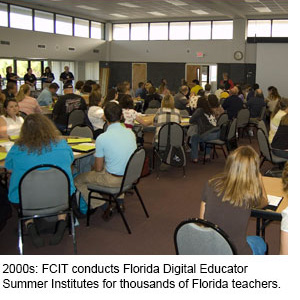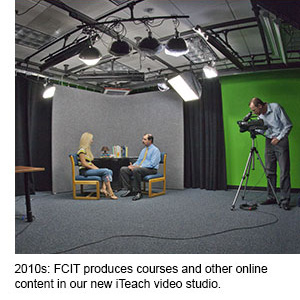A Short History of FCIT
 Since 1982, FCIT’s mission has been the integration of technology into K-20 education. In the early days, FCIT provided online tutorials as well as face-to-face training at our Tampa location. At that time, our professional development focused on finding appropriate programs for use in school computer labs and how to use the newly-established Florida Information Resource Network (FIRN). When not reserved for training sessions, our lab functioned as an active preview center for teachers in the Tampa Bay region. In those days before widespread connectivity, FCIT relied on print publications and diskettes for much of our outreach. Major grants from IBM in the 1980s helped familiarize schools with microcomputers and served as a catalyst for the creation of the Instructional Technology graduate programs at USF. In the 1990s, support from Apple and from Microsoft allowed us to offer additional professional development opportunities for teachers. Our online content included the Information Superhighway tutorial and A Teacher’s Guide to the Holocaust that we created in support of Florida’s mandate for Holocaust education.
Since 1982, FCIT’s mission has been the integration of technology into K-20 education. In the early days, FCIT provided online tutorials as well as face-to-face training at our Tampa location. At that time, our professional development focused on finding appropriate programs for use in school computer labs and how to use the newly-established Florida Information Resource Network (FIRN). When not reserved for training sessions, our lab functioned as an active preview center for teachers in the Tampa Bay region. In those days before widespread connectivity, FCIT relied on print publications and diskettes for much of our outreach. Major grants from IBM in the 1980s helped familiarize schools with microcomputers and served as a catalyst for the creation of the Instructional Technology graduate programs at USF. In the 1990s, support from Apple and from Microsoft allowed us to offer additional professional development opportunities for teachers. Our online content included the Information Superhighway tutorial and A Teacher’s Guide to the Holocaust that we created in support of Florida’s mandate for Holocaust education.
 By the turn of the century, FCIT was conducting over 100 full-day workshops every year on a variety of technology topics at our Tampa location and at other locations around the state on demand. A team of Educational Technology Integrators (ETIs) was funded by the Florida Department of Education to provide ongoing training and support for all districts across the state. We created the Exploring Florida website to support Florida History instruction via reading passages in an era where the instructional focus was on reading. Feedback from teachers and students regarding our resource collections around the topics of the Holocaust and Florida History encouraged us to create larger collections of digital content for classroom use. The success of our ClipArt ETC (Educational Technology Clearinghouse) website encouraged us to follow with collections of audiobooks (Lit2Go), photographs (ClipPix ETC), video (ClipVideo ETC), maps (Maps ETC), sound files (ClipAudio ETC), and presentation parts and pieces (Presentations ETC). These sites attracted teachers looking for classroom content and students looking for copyright-friendly material to include in reports, projects, and presentations. Soon, we were receiving several millions hits to these digital assets every school day.
By the turn of the century, FCIT was conducting over 100 full-day workshops every year on a variety of technology topics at our Tampa location and at other locations around the state on demand. A team of Educational Technology Integrators (ETIs) was funded by the Florida Department of Education to provide ongoing training and support for all districts across the state. We created the Exploring Florida website to support Florida History instruction via reading passages in an era where the instructional focus was on reading. Feedback from teachers and students regarding our resource collections around the topics of the Holocaust and Florida History encouraged us to create larger collections of digital content for classroom use. The success of our ClipArt ETC (Educational Technology Clearinghouse) website encouraged us to follow with collections of audiobooks (Lit2Go), photographs (ClipPix ETC), video (ClipVideo ETC), maps (Maps ETC), sound files (ClipAudio ETC), and presentation parts and pieces (Presentations ETC). These sites attracted teachers looking for classroom content and students looking for copyright-friendly material to include in reports, projects, and presentations. Soon, we were receiving several millions hits to these digital assets every school day.
In the 2000’s, we expanded our training offerings to include Florida Digital Educator four-day institutes that were conducted in all regions of Florida each year. Along with the Master Digital Educator program, which was also available for graduate credit at USF, these statewide trainings contributed to the development of many of today’s technology leaders in Florida.
By 2005, our experiences working with teachers to more effectively integrate technology into their classrooms led to the development of the Technology Integration Matrix, a practical guide for teachers striving to take their teaching practices to the next level. To assist schools and districts that had adopted the TIM, we developed a suite of evaluation tools that include a uses and perceptions survey, an observation tool, and action research support. The TIM Tools suite is now used in schools in over 30 states and in countries on six continents.
We expanded our range of online content by building the original iTunes U instance for USF, an instance for the Florida Department of Education, as well as one for the National Park Service. We expanded our online content to include virtual reality on our ClipVR ETC website and we created a series of Hispanic Heritage iBooks for the National Park Service.
 Responding to new demands and frequent requests from beyond Florida, FCIT now offers fully online courses through the iTeach Professional Learning program. These month-long courses are available to educators and administrators around the world. Our experienced facilitators, lead participants through activities designed to be of immediate practical application in their roles as educators or administrators. The Technology Integration Matrix courses are of particular interest to districts, states, and even entire ministries of education that have adopted the TIM as their model for technology integration.
Responding to new demands and frequent requests from beyond Florida, FCIT now offers fully online courses through the iTeach Professional Learning program. These month-long courses are available to educators and administrators around the world. Our experienced facilitators, lead participants through activities designed to be of immediate practical application in their roles as educators or administrators. The Technology Integration Matrix courses are of particular interest to districts, states, and even entire ministries of education that have adopted the TIM as their model for technology integration.
With increasing use of our digital content around the globe and a growing number of countries with schools adopting the Technology Integration Matrix, the Florida Center for Instructional Technology looks forward to a future of worldwide impact undreamed of when the Center was founded nearly four decades ago.
